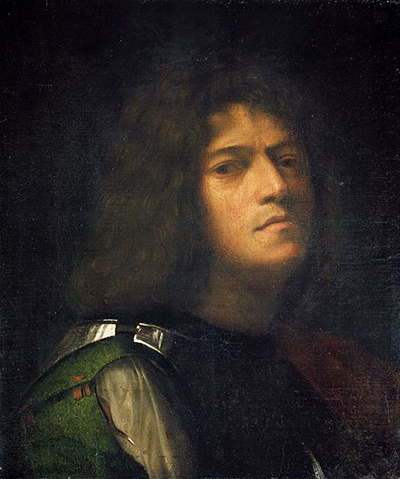Giorgione was short-lived. Despite being immensely popular and feted during his lifetime, his low output and the near impossibility of proving which works are his – he signed nothing during his lifetime, producing many frescoes most of which weathered away to shadows and fragments and only a few canvases.
Add to this the fact that Titan, soon to surpass his older contemporary – they were both students of Giovanni Bellini, celebrated master artist of the Italian Renaissance – finished many of Giorgione's incomplete works after Giorgione's untimely death, thought to be from the plague. Because of this, Giorgione, while acknowledged as a true master, is often the cause of hot debate and controversy, including some claims that he did not exist and was instead an early and temporary nom-de-plume of Titian!
However, this painting, called variously Self Portrait or The Artist as David not only tells us who painted it, it shows us his face revealing Giorgione the real man looking out from the canvas across a five-hundred year divide. It is said that Giorgione is just a nickname – which is a reasonable assumption as it translates to 'Big George' – of Giorgio Zorzo or Zorzi. He was so-named as he was very tall, unusually so for the time. And indeed, the man depicted is slouching with the manner of one who is used to not fitting into the world around him, of having to duck his head underneath lintels and crouch a little to use work surfaces and tables.
His back is rounded and his head is thrown back and he glances out from the canvas with a mildly interested and slightly puzzled look on his face, as though not quite sure what to make of what he sees. The portrait is dramatically lit, with the subject in darkness with light falling onto his face from the mirror so it seems as though the audience is holding up a lantern to illuminate the person in front of us. His brows are drawn together, while his soft dark hair, seemingly untreated, falls around his shoulders. A gleam of metal on his right shoulder, on top of his dark green tunic, gives an appropriately warlike appearance to conjure up thoughts of David, captured, perhaps, in contemplation of the problem of giant, working out how he, a mere boy can best such a behemoth of a being and moments away from thinking of his trusty catapult.
Perhaps Big George chose David as his self-subject ironically, drawing attention to his own height, or perhaps he was humble to do so – tall as he was, he was only human? There were two versions of this painting produced, with slightly different effects. The, in oil on paper, later transferred to canvas, other shows a warmer light, casting a reddish tinge onto the subject's face which is more centred than in the other. His mouth is set slightly differently too, showing more confidence and less uncertainty. This version offers a pale face and more concern, giving the subject a slightly aged and worried appearance. This version, which can be found in Herzog Anton Ulrich Museum in Germany, is painted in oils on a wooden panel.




